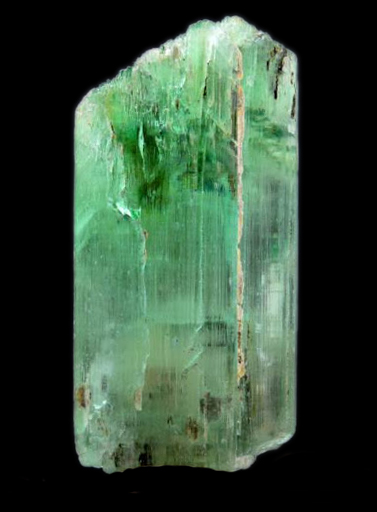
Crystal: Monoclinic
Cleavage: Perfect, Prismatic
Hardness: 6.5 - 7
Sp.G.: 3.03 - 3.23
Fracture: Uneven, Sub-conchoidal
Colour: Yellow, Green
Lustre: Vitreous, Pearly on cleavage.

| It benefits intellectual and
emotional experiences and Boosts
creativity. Zodiac: Scorpio |
Please read our DISCLAIMER
| Hiddenite is a pale to emerald green variety of spodumene that is sometimes used as a gemstone.
The first specimens of the hiddenite variety of spodumene were recovered in about 1879 near the tiny settlement of White Plains, west of Stony Point,
According to contemporary accounts, a young man named Lackey brought them to the attention of J.A.D. Stephenson, a local merchant who was also an ardent collector of minerals. Initially, the yellowish to greenish-yellow hiddenites were thought to be gemmy diopside. Stephenson brought the discovery to the attention of exploration geologist William Earl Hidden, who had been commissioned by Thomas Edison to search for any sources of platinum in North Carolina (an effort that was, in and of itself, unsuccessful). Hidden sent samples of the odd green material to J. Lawrence Smith, a prominent chemist and mineralogist of Louisville, Kentucky. Smith correctly identified the specimens as being a variety of spodumene, and named them "hiddenite" in honor of Hidden. The community in which the gemstones were first found would later be renamed "Hiddenite". During the hey-day of hiddenite mining in the 1880s and 1890s it was also known as "lithia emerald".
Hidden recognised the value of the emeralds and the potential of the new gemmy green spodumene. He acquired a tract of poor quality land, which was either the site of the initial discovery or near to it, for $1500. The Emerald and Hiddenite Mining Company was organized and excavations on the site quickly recovered loose hiddenites and emeralds in the red, gravelly clay. At a depth of about 26 feet they struck bedrock and soon were recovering hiddenites from solid rock. Oddly, period newspaper accounts and statements by George Frederick Kunz (1892) indicate that mining on the site was never undertaken as a full-time operation, but was only prosecuted a few weeks or months during the summer.
Writing in 1892, Kunz described the hiddenite being recovered as "always transparent, ranges from colourless (rare) to a light yellow, into a yellowish green, then into a deep yellow emerald green. Sometimes an entire crystal has a uniform green colour, but generally one end is yellow and the other green." |
|
for displaying and protecting your favourite minerals, gems, fossils, meteorites or other collectibles. We also make mineral display stands and acrylic blocks. FOLLOWING LINK BELOW: And DISPLAY PRODUCTS |